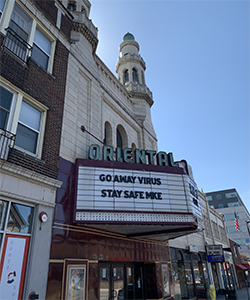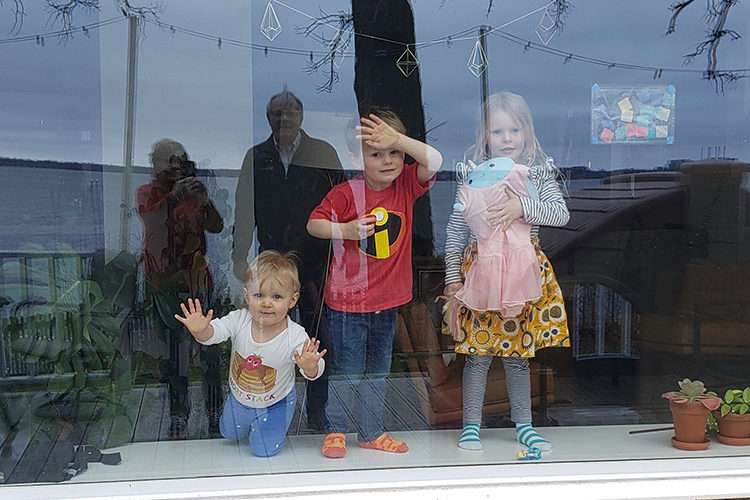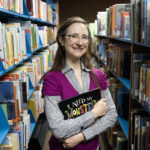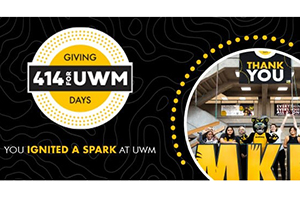A flag flies in Waukesha proclaiming “We will get through this.” Young girls a house apart play dolls by yelling out their second-story windows to each other. A hospital food service worker soaks her gloves in hand sanitizer to make temporary disinfecting wipes.
Chris Cantwell is capturing it all.
Cantwell, an assistant professor of history at UWM, is the creator of the COVID-19 MKE archive, an online repository that documents, in real time, how Milwaukee is experiencing the coronavirus pandemic. He’s compiled submissions from residents all around the metro Milwaukee area that give glimpses into a life in quarantine. There are some 600 posts and counting.
A community and student collaboration
The COVID-19 MKE archive was born partly from historians’ best practices and partly from necessity.
“This is actually established practice within the historical profession,” Cantwell said. “Any time something particularly dramatic happens or there’s an anniversary that comes up, museums will open their doors and say, give us material that will help us remember this moment 50, 60, 100 years from now.”

For instance, he noted, historians collected images of the roadside memorials that sprang up after the Boston Marathon bombing in 2013. George Mason University launched a digital archive in the wake of the September 11 terrorist attacks and received materials from around the world.
Likewise, as news spread of increasingly dire situations across the United States, Cantwell decided to document Milwaukee’s own response to the pandemic. He worked with the UWM Libraries – including Ann Hanlon, the library’s director of digital initiatives, and Jie Chen, a digital collections application specialist who handles the site’s server space – to launch the website and begin collecting submissions in the form of blog posts, videos, photographs, audio clips and social media posts.
Salvaging the semester
But this archive is also a way for Cantwell to salvage his semester. Cantwell helps run UWM’s public history program, and, like all UWM faculty, in March he had to shift his courses online for the remainder of the semester to prevent further spread of the virus. While that keeps his students safe, it also disrupts their coursework. Each semester, he usually asks his graduate students to do a deep dive into the history of a local Milwaukee place of worship.
“As the news began to unfold, it became clear very quickly that that project wasn’t going to be possible or sustainable. All of the places of worship they were working with started closing,” Cantwell said. “But I started thinking, the challenges of this moment were also an opportunity.”
As the semester progressed, the students became more responsible for guiding and curating the archive. They were also asked to gather oral histories from community members to add to the site.
“I’m going to work collaboratively with my students to identify what communities we should talk to. What kinds of sources should we be looking to that are reflective of this moment?” Cantwell said. “I want to let them decide who they can work with, who they have access to at this moment, and who they think is important.”
History in real time
History is usually written with a bird’s-eye view of the past. Documenting history as it happens is a challenge because there’s no telling what material will end up being significant.
“In some sense, I don’t know what’s important; I want people to tell me,” Cantwell said. “On the other hand, I know what’s important is to save the stuff that’s going to disappear quickly (like Facebook or Twitter posts).”

There’s an argument, too, that documenting history as it happens is the job of newspapers and journalists. Major news outlets across the country have covered the political and economic fallout of the COVID-19 pandemic extensively, while smaller, community newspapers and television stations have focused on local responses.
But, Cantwell said, this archive houses the things that can’t make it into a newspaper. Media outlets are limited by the amount of space and time they have available to print or broadcast stories, so journalists devote themselves to analyzing and interpreting the important facts.
“Our mission is more to aggregate and curate than it is to interpret,” Cantwell said. “Journalists are trying to find the signal in the noise, and we just want to capture the noise. We provide the space for everything that falls on the journalists’ cutting room floor.”
How Milwaukee can help
Anybody willing to share their experiences about weathering the coronavirus pandemic in Milwaukee can contribute to the archive. Cantwell said he is hoping people will take some time to contribute stories to the site that detail their personal experiences with social distancing.
He would also like to include accounts from grocery store clerks and other essential employees, educators who are working to teach their students remotely, and medical workers – though he acknowledges those folks are probably a little busy at the moment.
“I think we have enough pictures of empty shelves,” he added. “We’ve cornered the market on empty toilet paper and bread shelves.”
Anyone who has suggestions to improve the site can contact Cantwell and his students through the website’s contact tab.







